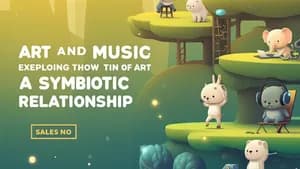This article explores the surprising connections between artistic movements and musical genres, demonstrating how historical periods often saw parallel developments in both art and music. We'll examine specific examples showing shared themes, aesthetics, and underlying cultural forces influencing both disciplines. Understanding these parallels can significantly enrich your appreciation and comprehension of both art and music.
The Renaissance: A Rebirth in Art and Music
The Renaissance, spanning roughly from the 14th to the 17th centuries, witnessed a flourishing of both artistic and musical creativity. In visual arts, we see the shift from the stylized religious art of the Medieval period to a renewed focus on realism, humanism, and classical forms. Artists like Leonardo da Vinci, Michelangelo, and Raphael celebrated human anatomy, perspective, and emotion in their paintings and sculptures. Simultaneously, music experienced a similar rebirth. The complex polyphony of the late medieval period gave way to a clearer, more balanced style. Composers like Josquin des Prez and Giovanni Pierluigi da Palestrina developed sophisticated vocal techniques, emphasizing harmony and counterpoint, mirroring the balance and harmony sought in Renaissance paintings. To understand this connection, try focusing on the shared emphasis on order and proportion in both art and music of this time. Compare the balanced compositions of Renaissance paintings to the balanced vocal lines in a Palestrina motet. This comparative approach will deepen your understanding of the period.
The Baroque: Drama and Ornamentation
The Baroque period (roughly 17th-18th centuries) is characterized by its dramatic intensity and ornate style. In art, think of the swirling compositions of Caravaggio, the grandeur of Bernini's sculptures, and the lavish detail in paintings by Rubens. Music mirrored this exuberance. Composers like Johann Sebastian Bach and George Frideric Handel created complex, emotionally charged works characterized by elaborate ornamentation and dynamic contrasts. Bach's fugues, with their intricate interwoven melodies, echo the complex detail and interplay of forms seen in Baroque painting. Handel's operas, with their dramatic narratives and powerful arias, similarly mirror the theatrical quality of Baroque sculpture and painting. To appreciate this connection, actively listen to the music while observing Baroque paintings and sculptures. Pay close attention to the emotional impact and the use of light and shadow in both art forms. This active engagement will help you grasp the period's dramatic spirit.
The Romantic Era: Emotion and Individuality
The Romantic era (late 18th and 19th centuries) placed a strong emphasis on emotion, individualism, and imagination. In art, artists like Eugène Delacroix and Caspar David Friedrich captured the power of nature and the intensity of human emotion through vibrant colors and expressive brushstrokes. In music, composers like Ludwig van Beethoven, Franz Schubert, and Frédéric Chopin explored a wide range of emotions through their compositions. Beethoven's symphonies, with their dramatic shifts in mood and intensity, mirror the emotional depth in Romantic paintings. Chopin's nocturnes evoke a sense of longing and introspection that complements the solitary figures often found in Romantic landscape paintings. You can develop a deeper appreciation by analyzing the use of dynamics and tempo in Romantic musical compositions and comparing them to the expressive brushstrokes and emotional intensity in paintings of the same era. For instance, analyze the emotional arc of a Beethoven symphony and relate it to the changing moods in a Delacroix painting.
Impressionism and Post-Impressionism: Capturing Light and Subjectivity
Impressionism in art, prominent in the late 19th century, focused on capturing fleeting moments and the effects of light. Artists like Claude Monet and Pierre-Auguste Renoir used short, broken brushstrokes and vibrant colors to depict the world as they perceived it. Music, while not directly mirroring Impressionism in the same way, showed parallel developments in its emphasis on capturing fleeting sensations and subjective experiences. Composers like Claude Debussy and Maurice Ravel explored new harmonic and melodic techniques to create a more evocative and ethereal sound. Debussy's use of whole-tone scales and impressionistic harmonies evokes the hazy light and diffused forms in Monet's paintings. To connect these art forms effectively, consider listening to Debussy's music while looking at Impressionist paintings. Focus on how both art forms create an atmosphere or mood, rather than depicting concrete scenes or emotions. Pay attention to how colors and sounds work together to achieve a similar effect.
Modernism and Beyond: Experimentation and Abstraction
The 20th century saw a profound shift in both art and music, with modernism embracing experimentation, abstraction, and a rejection of traditional forms. In visual arts, movements like Cubism, Surrealism, and Abstract Expressionism challenged established norms. Similarly, composers like Igor Stravinsky, Arnold Schoenberg, and Béla Bartók pushed the boundaries of musical language, experimenting with atonality, dissonance, and new compositional techniques. Stravinsky's rhythmic innovations in his ballets mirror the fragmented perspectives in Cubist paintings. Schoenberg's twelve-tone system represents a radical break from traditional tonality, mirroring the revolutionary spirit of many modern art movements. Connecting these art forms requires careful examination of the innovative techniques used. Consider the way that Cubism breaks down and reassembles forms and how this mirrors the reimagining of traditional musical structure in atonal music. Comparing and contrasting the techniques in different works from these movements will significantly improve your understanding.
Conclusion
By exploring the parallel developments in art and music history, you can gain a richer, more nuanced understanding of both disciplines. The shared themes, aesthetic choices, and underlying cultural forces that shaped these parallel movements offer a fascinating glimpse into the interconnectedness of human creativity and the evolution of artistic expression. Remember to engage actively with both art and music, comparing and contrasting works from different eras and movements to appreciate their interconnectedness fully. This approach will not only enhance your knowledge but also deepen your appreciation for the beauty and power of artistic expression in all its forms.

